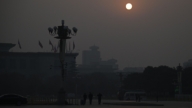【新唐人2011年2月15日讯】中国大陆物价节节上升,中共为了维稳,竭力要稳定食品价格以控制通货膨胀。然而,中国北部降水量稀少,严重旱情得不到缓解,夏季小麦产量面临危机;而旱灾也有向南部蔓延的趋势,影响全国农作物收成。中共抑制粮价维稳恐怕无效,物价上涨压力仍将持续。
自去年9月底以来,山东大部分地区近140天基本无有效降水,发生严重的秋冬春连旱。9月底到今年1月底,山东省累计平均降水量仅12毫米,比常年偏少85%。大陆媒体报导,如果到2月底仍然没有大范围有效降水,全省气象乾旱将达到200年一遇,部分城市会达到500年一遇;如果三月底仍无大范围有效降水,全省气象乾旱等级或达到千年一遇。
据了解,2月9号到11号,中部和东部大部分地区将有雨雪天气,但河南、江苏北部、安徽北部这带地区降水量比较小,对旱区旱情缓解的作用十分有限。
安徽阜阳的农民对海外记者表示,当地有四个月不降雨,原本是盛产小麦的地方,如今小麦被渴死,麦田如荒地。当地没有水库,目前大大小小的沟、河都已经干枯见底,农民面临小麦绝收,倒贴本钱购买粮食的境况。
雪上加霜的是,北方的麦区旱情正向南方省份蔓延,湖北省农业厅初步统计,截至目前为止,湖北省已有800多万亩农田受旱。自去年11月以来,湖北省西北、东北、江汉平原北部降雨量仅13到24毫米,与历史同期相比偏少六到八成。
美国《纽约时报》8号报导,联合国粮农组织已经发出警告,作为世界最大的小麦生产国,中国正面临严重干旱,而这可能给世界粮食市场造成影响。如果中国被迫从国外进口粮食,将对世界粮食市场产生巨大冲击。
此前,联合国粮农组织发表报告说,今年1月,全球食品价格指数连续7个月上升,超过2008年“粮食危机”峰值,为1990年以来最高,粮农组织并就中国干旱可能对粮食价格的影响发出预警。
今年春节后首个交易日,小麦、玉米和水稻三大粮食期货大幅上涨,小麦期货更是出现了罕见的涨停行情。玉米和稻谷期货跟随小麦上涨,其中玉米主力合约单日上涨2.23%,早籼稻上涨2.31%。随后的两个交易日,资金炒作农产品的热情不减。
而《自由亚洲电台》报导,湖北省农业厅办公室的官员表示,目前“油菜灾情”比小麦严重。
据《广州日报》消息指出,粮食价格上涨已经传导到了终端饭馆、市民餐桌上。去年每斤1.98元的东北大米,今年已经涨了三成,卖到了每斤2.65元。而一袋面粉价格由半年前的70多元涨了15%,达到80多元。
中证期货农产品分析师麦兆铭也认为,长期来看粮食价格易涨难跌。而短期粮价的暴涨可能导致1月份的消费者指数(CPI)可能超过5%。
新唐人记者吴惟,李若琳综合报导。
Drought Jeopardizes Chinese Wheat Production and Heightens Inflation Pressure
Commodity price in China is escalating.
In order to maintain stability, Chinese authorities
are trying desperately to control prices
so as to control inflation.
In northern China, however, rain becomes scarce
and draught continues.
Wheat output in the summer is facing a crisis.
Draught is spreading to the South and
will affect the nation’s harvest.
The effort to suppress price of rice may be in vain
and the pressure of inflation will continue.
Since last September, there has been no effective rain
for 140 days in most of Shangdong Province.
Serious draught occurred in autumn, winter,
and spring in a row.
From late September to late January,
the ccumulative average precipitation is only 12 mm
in Shandong Province, 85% less than the average year.
Mainland media reported that
if there is no effective rain by the end of February,
the province will have a meteorological drought
once in 200 years.
Some cities will have a draught once in 500-years.
If by the end of March, there is still no effective rain
in large areas,
the provincial meteorological drought will reach
once in a 1000 years.
Sources said that from Feb 9 to 11, rain and snow
hit middle and eastern area of China,
but still not much rain in Henan, north of Jiangsu,
and north of Anhui.
It cannot effectively alleviate the draught.
Farmers from Fuyang, Anhui, told overseas reporters
that there was no rain for 4 months in the local area
and wheat crops died in the wheat-rich area.
Wheat field became a wasteland.
There is no reservoir in local area.
Rivers and ditches dried up.
Farmers will have to spend money to buy food.
What’s worse is that the wheat area draught
in Northern China is spreading to the South.
Statistics by Agriculture Department of Hubei
show that so far 1.3 million acres of farm land
have been affected by the draught.
Since last November, rain only reached 13 to 24 mm
in North-West, North-East of Hubei Province and
Jianghan Plain,
60% to 80% less than the previous years.
New York Times reported on Feb 8, FAO has given
a warning that as the biggest wheat producing country,
China is facing serous draught and may affect
world food market.
If China is forced to import food from abroad,
the world grain market will be seriously hit.
Earlier, FAO published reports saying last January
is the 7th month of rising food price index and
it has surpassed the peak price in 2008 Food Crisis,
the highest since 1990.
FOA gave an early warning of the impact that
China’s draught has brought to the food prices.
On the first trading day after Chinese New Year,
wheat, maize, and rice futures surged and
wheat futures reached a rare stock limit.
Maize and rice futures surged with wheat.
Main corn contract rose 2.23% for the day and
early rice contract rose 2.31%.
In the following two trading days,
speculation on agricultural capital kept rising.
Officials from Agricultural Dept of Hubei Province
told RFA that the current “canola disaster”
surpasses “wheat disaster.”
Guangzhou Daily reported that food price rise
has spread to restaurants and dinner tables.
North-Eastern rice has reached 5.3 yuan a kilo,
30% increase from previous 3.96 yuan a kilo.
Price for a bag of flour has reached over 80 yuan,
a 15% increase from six months ago.
Mai Zhaoming, an agricultural future analyst
from CSI said that on a long term basis,
food price is easy to rise and hard to drop.
The food price surge on a short term basis
may lead to Jan. CPI rise over 5%.
NTD reporters Wu Wei and Li Ruolin




























